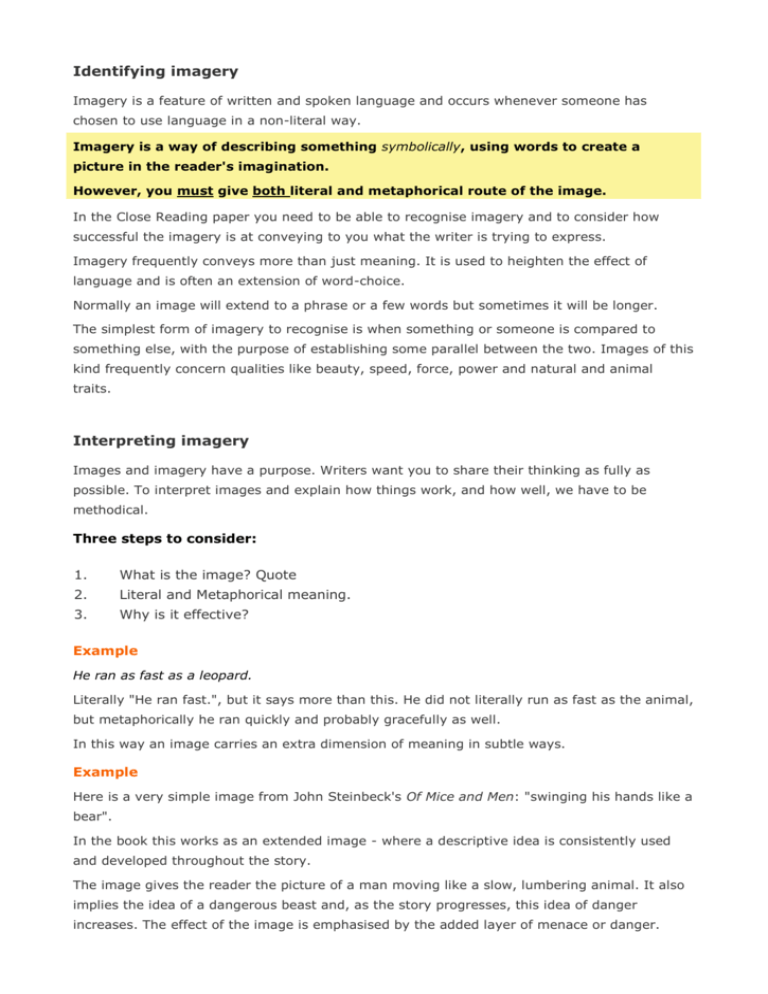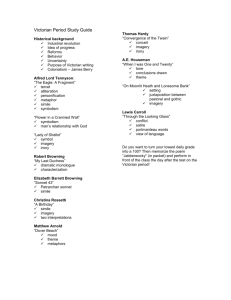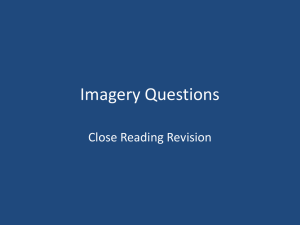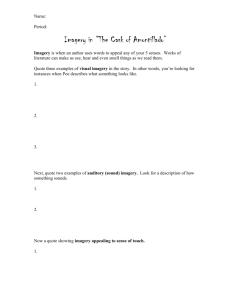Higher Identifying imagery.doc
advertisement

Identifying imagery Imagery is a feature of written and spoken language and occurs whenever someone has chosen to use language in a non-literal way. Imagery is a way of describing something symbolically, using words to create a picture in the reader's imagination. However, you must give both literal and metaphorical route of the image. In the Close Reading paper you need to be able to recognise imagery and to consider how successful the imagery is at conveying to you what the writer is trying to express. Imagery frequently conveys more than just meaning. It is used to heighten the effect of language and is often an extension of word-choice. Normally an image will extend to a phrase or a few words but sometimes it will be longer. The simplest form of imagery to recognise is when something or someone is compared to something else, with the purpose of establishing some parallel between the two. Images of this kind frequently concern qualities like beauty, speed, force, power and natural and animal traits. Interpreting imagery Images and imagery have a purpose. Writers want you to share their thinking as fully as possible. To interpret images and explain how things work, and how well, we have to be methodical. Three steps to consider: 1. What is the image? Quote 2. Literal and Metaphorical meaning. 3. Why is it effective? Example He ran as fast as a leopard. Literally "He ran fast.", but it says more than this. He did not literally run as fast as the animal, but metaphorically he ran quickly and probably gracefully as well. In this way an image carries an extra dimension of meaning in subtle ways. Example Here is a very simple image from John Steinbeck's Of Mice and Men: "swinging his hands like a bear". In the book this works as an extended image - where a descriptive idea is consistently used and developed throughout the story. The image gives the reader the picture of a man moving like a slow, lumbering animal. It also implies the idea of a dangerous beast and, as the story progresses, this idea of danger increases. The effect of the image is emphasised by the added layer of menace or danger. Using simile and metaphor Imagery is a figurative comparison between two things which have no literal connection. By comparing things that are not alike, writers use imagery to create a poetic or descriptive impact. Effective imagery works by allowing readers to compare something they are familiar with to something less familiar. There are two very easily recognised forms of imagery: similes and metaphors. Simile Similes are simple comparisons and usually contain the word 'like' or 'as' For example: "As cool as a cucumber" describes someone who is calm and composed. "Like a fox in a henhouse" describes dangerous carnage. Metaphor Metaphors involve comparison like similes but they do so more subtly than similes. Where a simile tends to describe a comparison by making a simple association like the examples above, a metaphor suggests the comparison without stating it explicitly. For example: "A trickle of aid to sub-Saharan countries came from the West last year instead of the necessary flood" illustrates that a natural force like water can be used to describe the way that third-world countries are provided with aid. The image relies on the 'trickle' being a slow flow of water inadequate for the purpose of useful aid to the sub-Saharan countries, contrasted with 'flood'; the large volume of support actually needed. Example His wife sat in her fur coat in the car like a drugged bear. The simile compares the woman in the car with a 'drugged bear'. It works by making a physical comparison; bears have coats like the woman's. And like a bear she is large and ponderous. The simile extends by introducing the word 'drugged'; this suggests that, like a tranquillised animal, the woman might also be dangerous if roused. The image is successful and effective because it goes beyond the physical description of a bear and a woman and introduces ideas of behaviour and character. It's also quite a funny idea. Example We have to get to the heart of the matter. The metaphor suggests the need to get to the core, or most important part, of something. It works by comparing something of central importance to the most essential organ in the body. Both are vital. The image is effective because the heart is literally the centre of our existence and the comparison emphasises the importance of the essential centre of what is being discussed. Task: Look at the following examples of images and try to give the literal and metaphorical means of each. Answers are on the BBC Bitesize website. He was squashed like a frog under the wheels of a bus. He has allowed himself to become insulated from reality and have his feathers preened by those around him. What sort of image is this and why is it effective? I fear that we have awakened a sleeping giant and filled him with a terrible resolve. Admiral Yamamoto, about the Japanese attack on Pearl Harbour How effective is this image in its context? Now, on the lamp-lit avenue, he stopped and saw his callousness as evil, able to take all beauty from life; the brightness from the moon, the fragrance from roses... Why is this image effective in evoking the man's character? Time to confess. I'm a big fan of Taggart. I have been for years, which I guess makes me old. By now this famed cop series has been transformed into a comfy, raddled old armchair, one which I slump into. The DNA boys have checked out its stains. CID have reached down the back in search of blood-encrusted weapons. In a sense that chair is also, metaphorically, Glasgow. Last night I sighed and sank into its old, familiar deeps. I was oh-so deeply disappointed. The show has, over the years been reupholstered more than once. What is the image? How effective is it and why? No basket ever carried more eggs than young Alec did hopes that Friday. What is the image? How effective is it and why?






